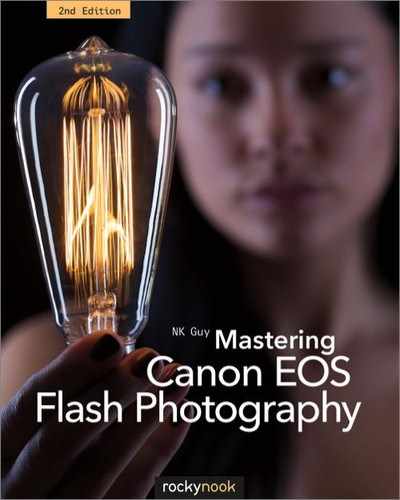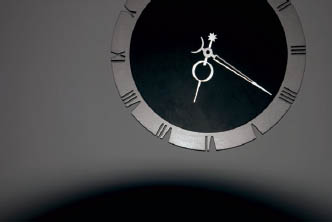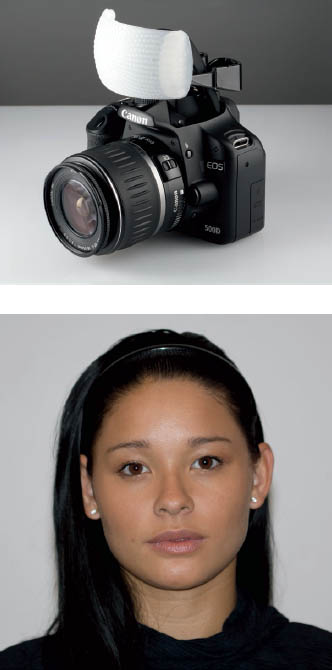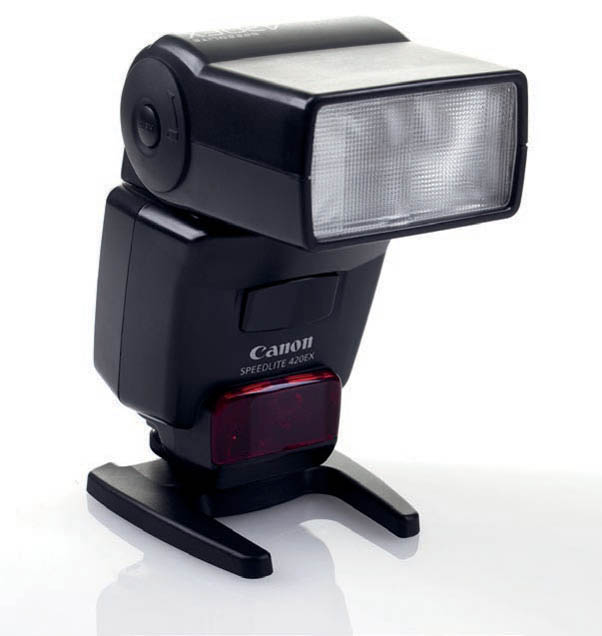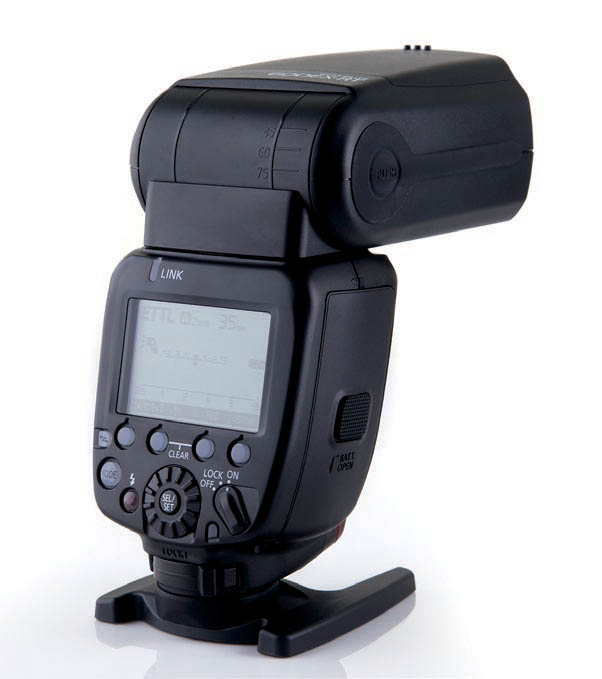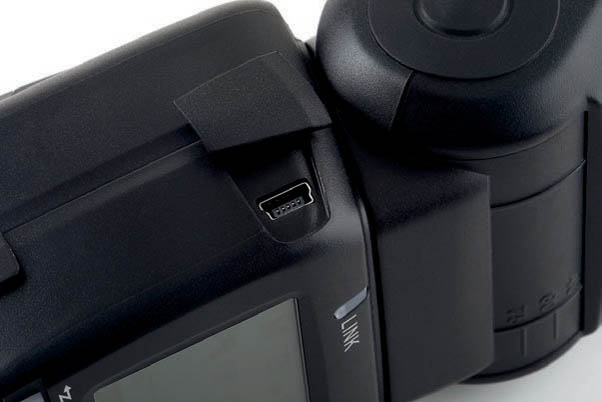8 Dedicated Flash Units
Six Masks. Historic Japanese Noh masks, courtesy Noh master Jiichi Asami of Shibuya, Tokyo, Japan. 580EX II flash unit on an off-camera shoe cord, shooting into a Westcott collapsible silver umbrella. Each mask was shot individually, then combined to form a single picture. EOS 5D, 1/60 sec at f/4, ISO 100, 70 mm.
This is an example of portable automatic E-TTL flash, using an off-camera flash unit with shoe cord.
A dedicated flash unit is one that contains computerized electronics and that is designed uniquely for one particular camera maker’s products.
In the early years of electronic flash photography, synchronization with the shutter was the only control the camera had over the flash unit. The output level and shutoff time were both determined by the flash unit itself, since two-way communications between camera and flash unit weren’t possible.
In the 1960s and ’70s, companies such as Honeywell, Braun, and Vivitar had thriving sales of autoflash units that worked with any SLR. Such generic products had simple electrical contacts to receive the camera’s flash sync signal.
However, in the 1980s camera makers started building “dedicated” flash systems that would enable advanced features such as flash metering—but only with their own products. No universal standards were ever developed for camera-to-flash communications. In terms of automated features, a Nikon camera can’t use a Canon flash unit, a Pentax flash unit can’t be used with a Sony camera, and so on.
8.1Built-in (popup) flash
The most dedicated flash units are those built right into the camera body. Nearly all consumer-level Canon EOS cameras have integral flash units in the angular prism or mirror housing. These internal units are handy for quick snapshots, since they’re available at a moment’s notice. They can’t be misplaced or forgotten, can apply a little fill flash when outdoors, and recharge rapidly off the camera’s own battery.
Built-in flash units are mounted on a hinged assembly and are normally retracted. Some are motorized and pop up immediately in most icon modes if the camera thinks flash is needed, or at the touch of a button when in a “creative zone” (letter) mode. A few have no motors and require the user to lift up the head manually.
8.1 Older EOS film cameras, such as the EOS 5/A2 (left), often had large flash housings containing motorized zoom mechanisms (section 9.5) and redeye lamps (section 9.8). Early digital EOS models such as the EOS 10D (center) eliminated the zoom motors and lamps, resulting in lower profile flash housings. Later EOS digitals such as the 50D (right) feature longer flash arms, allowing the flash head to be raised higher from the camera body.
8.2 The tiny EOS M3 mirrorless camera has this incredibly complex and delicate popup arm. Personally, I think a telescoping tube like a radio antenna would have been a sturdier mechanism for extending the flash head up, but then I’m not a camera designer.
Most EOS film cameras use TTL metering for popup flash, whereas digital cameras use E-TTL. Some post-2007 cameras also support manual metering with popup flash. Canon sometimes calls built-in flash “serial controlled,” meaning computer-controllable.
8.1.1Popup flash limitations
Unfortunately, built-in flash units have many drawbacks.
8.3 The classic crescent shadow shown above is a hallmark of popup flash that has been blocked by a lens hood.
- They have very limited power output and range: typical guide numbers are around 11 to 13. This is fine for snapshots of friends in restaurants, but not much more than that.
- They’re located fairly close to the lens, and so likely to cause the redeye effect.
- They don’t extend very far above the camera body, so the light can be partially blocked by large lenses or large lens hoods.
 8.3
8.3 - They don’t tilt or swivel and generally have coverage areas of only 28mm or 35mm (18mm to 22mm on crop sensor cameras).
- They run down the camera’s battery more rapidly.
- Only post-2007 cameras can use built-in flash as optical wireless E-TTL masters.
- Finally, and most importantly, they don’t offer particularly nice lighting quality, since lighting rarely looks good originating from tiny on-camera sources.
8.4 Error message 05, resulting when an external flash unit is mounted on the hotshoe.
You can’t use internal flash and a shoe-mounted flash unit at the same time, as they’d physical collide. An EOS camera with a motorized internal flash unit has small electrical switches built into the hotshoe that detect the presence of a device and disallow internal flash popup, issuing errors BC, 05, or 83 depending on the model (figure 8.4). The internal flash won’t rise automatically even if a bubble level or something else non-electrical is mounted on the hotshoe. The switches can also occasionally stick, rendering the internal flash inoperable.
None of the professional EOS cameras (1, 3, 5D, 6D series) have built-in flash units for the reasons listed above and because of the difficulty of weatherproofing a popup flash mechanism.
8.1.2Improving built-in flash
It’s pretty well guaranteed that if the popup flash is turned on and ambient light levels are low, you’re going to end up with lousy photos. Or, to be more fair, harshly lit photos. This may be the whole point, and plenty of edgy fashion shots are taken this way deliberately, but generally speaking, built-in flash is a bad choice for aesthetics.
There are three ways around this. The first is to avoid flash altogether and rely on ambient light. The second is to use an external flash unit or units, particularly positioned off-camera. The third is to install a flash accessory over the built-in flash. These come in two forms: diffusers and reflectors.
Gary Fong Puffer
The Puffer is a small plastic diffuser that fits on a frame and slides into the camera’s hotshoe. The frames avoid the shoe’s sensors, which normally would disable the popup flash’s electronics.
It’s meant to enlarge the light-emitting surface area slightly and reduce its specular nature. It also spreads light around, which can be handy if there are nearby walls or ceilings for the light to bounce off. On the whole, it cuts the harshness a bit but doesn’t reduce directionality, it’s easily broken, and is an extra thing to carry. ![]() 8.5
8.5
8.5
Professor Kobré’s Lightscoop
The Lightscoop takes a different approach. It’s a mirror inside a plastic frame, which fits inside the camera’s hotshoe. It reflects the light from a popup flash straight up to the ceiling, so it’s completely useless if there’s no ceiling. The device is meant for use indoors with light-colored low ceilings, or if you turn the camera to portrait orientation, the light can be direct toward a wall. ![]() 8.6
8.6
8.6
However, built-in flash units are pretty weak, and a lot of light is lost when it’s bounced. For this reason, the manual tells you to set the camera to ISO 800, flash exposure compensation to +2, and the aperture to the widest setting possible.
If you’re okay with shooting at ISO 800, then the device works well enough, but that’s a significant drawback right there. It’s also as big as a flash unit to carry around and, since it deflects most light upwards, it provides little frontal fill; you run the traditional risk of “raccoon eye” shadow.
8.2Canon Speedlites
Canon has made many add-on flash units for its cameras over the years. All are marketed under the “Speedlite” name, and all are lightweight, battery-operated devices that plug into or fasten onto the hotshoe attachment of every EOS camera. All Speedlites since 1987 have been fully integrated with the Canon EOS system, offering automatic flash metering and other features.
8.7 The basic Speedlite lineup back in 2009: 270EX, 430EX II, and 580EX II.
They come in five basic physical configurations: small hotshoe flash units, standard and pro tilt-head hotshoe flash units, handle flash units, and macro flash units.
8.8
8.2.1Small hotshoe flash units
These tiny pocket-sized boxes are the most basic models. Most have fixed flash heads that can’t be tilted or rotated. They produce a bit more light than a popup flash unit, but their limited output restricts them to casual indoor photography, nothing more. They include Speedlites 160E, 200E, 300EZ, 90EX, 200EX, 270EX, and 270EX II. ![]() 8.8
8.8
8.2.2Consumer-level tilt-head hotshoe flash units
This is what most people think of when they think of an external flash unit for a camera. Occasionally known as a “cobra” design because of its form, the L-shaped hotshoe flash with an independently tiltable head is ubiquitous; most camera makers produce similar products. The consumer-level units offer reasonable power output but most lack advanced features such as the ability to control other flash units wirelessly. They include Speedlites 320EX, 380EX, 420EX, 430EX, 430EX II, and 430EX III/430EX III-RT. ![]() 8.9
8.9
8.9
8.2.3Pro-level tilt-head hotshoe flash units
The most full-featured flash units in the Canon lineup are the pro models, which are larger and more powerful than their consumer counterparts. They often support features such as wireless master control, rapid recharging, stroboscopic output, and weatherproofing. They include Speedlites 420EZ, 430EZ, 540EZ, 550EX, 580EX, 580EX II, and 600EX/600EX-RT. ![]() 8.10
8.10
8.10
8.2.4Handle flash units
Canon only made only one model of this design for EOS cameras, but some other makers, such as Metz, continue to produce them. They’re large, high-output devices made in the shape of a big handle or grip with an integral flash bracket. They are often used by news photographers and the like. This is the film-only Speedlite 480EG. ![]() 8.11
8.11
8.2.5Macro flash units
These are specialized flash units with small flash tubes that fasten to the end of a macro lens. They may have a ring shape or independently movable heads. Because they’re intended for close-up photography, they don’t have particularly high light output, making them unsuitable for general photographic use. They include the Macro lites ML-3, MR-14EX, MT-24EX, and MR-14EX II. ![]() 8.12
8.12
8.11
8.12
8.3Speedlite naming scheme
The nomenclature of Speedlites is consistent and fairly logical. Here’s what “Speedlite 580EX II,” a typical example, means.

All Speedlites shipping at time of writing are EX units, and most work with the majority of film and all digital EOS cameras. Units starting with “M,” such as the MT-24EX, are macro flash units. Other ending codes include the following:

Although this naming system is reasonably logical and consistent, it’s easy to confuse different models that happen to have identical guide numbers. For example, the 430EZ and 430EX flash units are completely different products despite the single letter difference, as are the 420EZ and 420EX. It thus pays to be very careful when shopping for used flash products. EZ units, for example, are not compatible with digital EOS cameras.
8.4Older Canon Speedlites
Older Canon Speedlites lack the letter E in their names and predate EOS cameras. They are not useful with modern cameras.
Such units will physically fit an EOS camera’s hotshoe and may trigger at full power when a photo is taken, but they can’t use modern automated flash metering. They have to be used in autoflash mode if they have such a setting (set the camera to a shutter speed up to the camera’s X-sync) or in manual mode if they have manual controls (most don’t), or else the units will fire at full power. Many should have a safe triggering voltage, but always check before attaching one of these vintage units to a camera.
The one exception is the 300TL. It was designed for the Canon T90 but can be used with EOS film cameras in basic TTL mode. ![]() 8.13
8.13
8.13 Canon Speedlite 300TL
8.5Third-party flash units
A number of companies (“third parties” such as Metz and Sigma) sell flash units for the EOS system. However, Canon has never published or licensed the data protocols—the digital language—used by its cameras. So, any flash product billed by a third party as being Canon compatible has been made through a process known as reverse engineering. The third parties have examined the behavior of existing Canon products, deciphered the command language used to control them, and made their own compatible products.
While reverse engineering is effective when done diligently, there is one significant risk. Canon can alter the design of its products at any time. When this occurs, there is the possibility that older third-party units will not be able to communicate with newly released products.
Occasionally Canon will introduce a new line of products that breaks compatibility with previous products. For example, the switch from film to digital meant that newer digital cameras could not use older TTL flash units. Generally speaking, however, Canon ensures that new products can operate well with its older lineup. A brand new Speedlite 600EX-RT, for example, will work just fine on an EOS 650 camera from 1987, though of course the camera won’t be able to use of all the Speedlite’s new features. Be cautioned that Canon does not test third-party products for compatibility issues during development; Canon just tests its own.
8.14 Sigma EF-530 DG Super Flash unit
8.15 Mecablitz 15 MS-1 ring flash
Some third-party products are upgradable to avoid this risk. For example, more recent Metz and Yongnuo flash units have USB connectors so the latest firmware (internal computer software) can be downloaded from the Internet to the flash unit if the manufacturer releases an update to improve compatibility or to fix bugs. Most third-party units do not have this level of “future-proofing” built in, though it’s sometimes possible to send a unit to the manufacturer for firmware upgrades.
Another common problem involves AF assist lights. Almost all third-party flash units cannot illuminate the AF assist light when a focus point other than the center point is selected on a multiple focus point camera.
8.16 This small USB mini B socket is used for upgrading the firmware on a Yongnuo flash unit.
